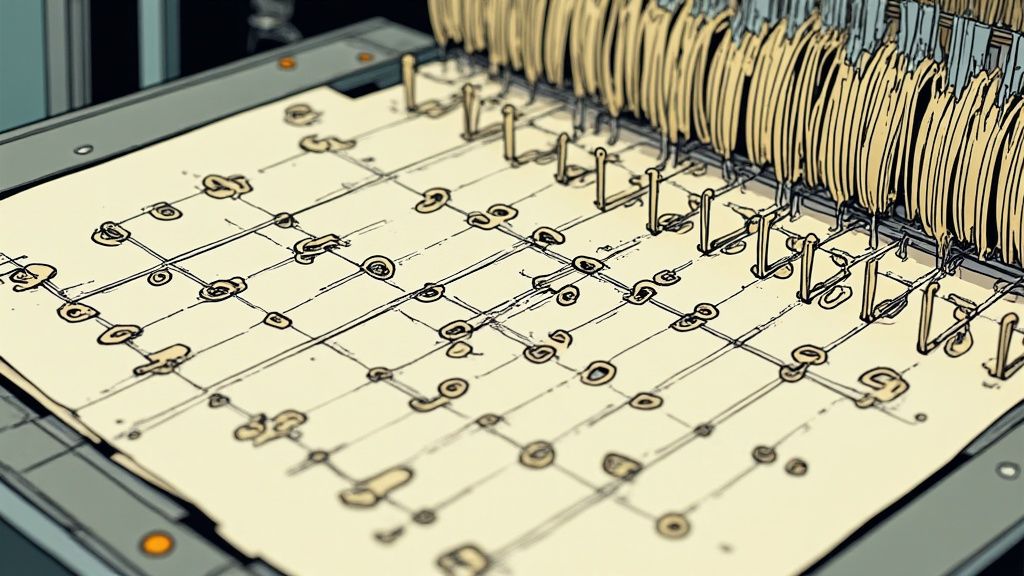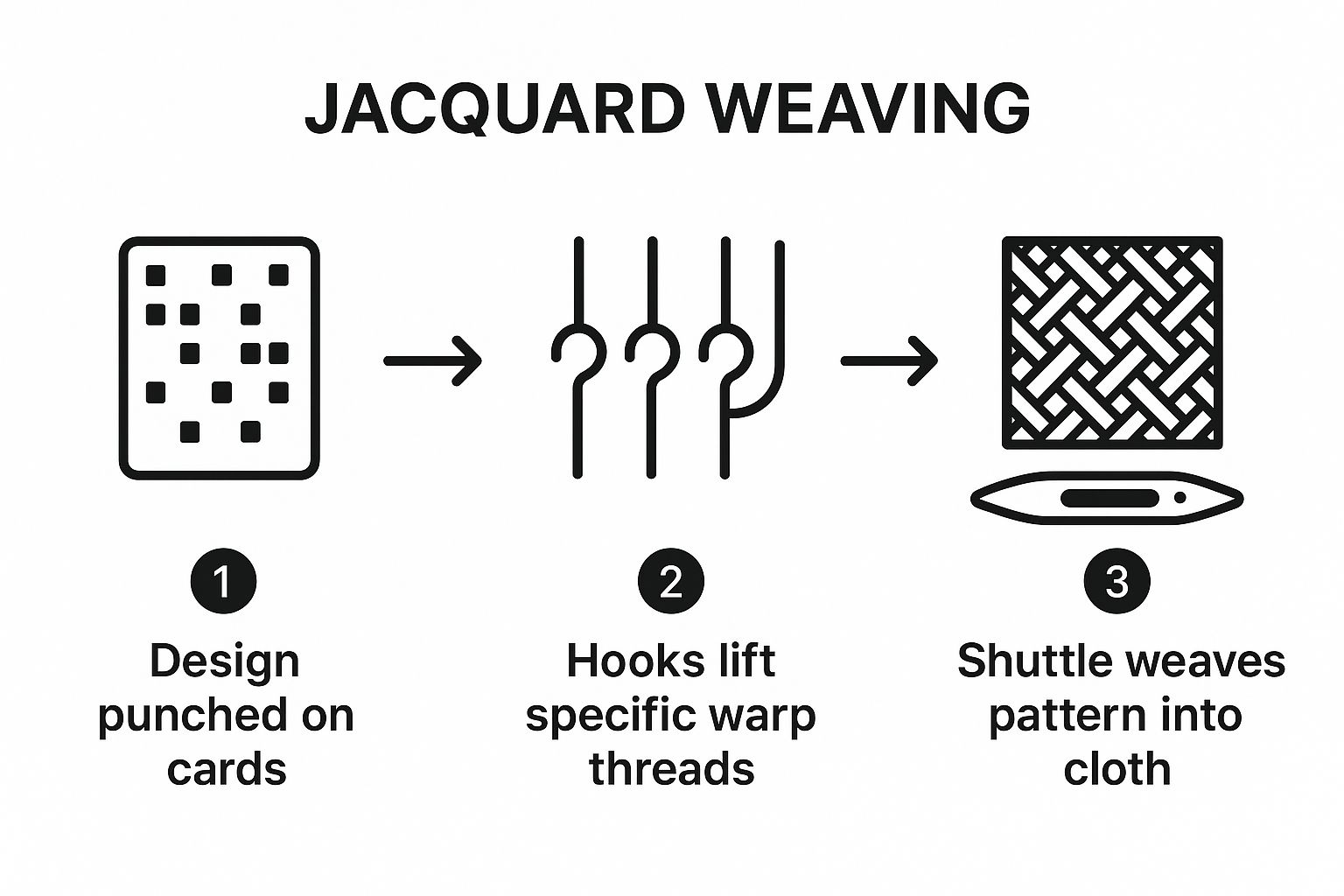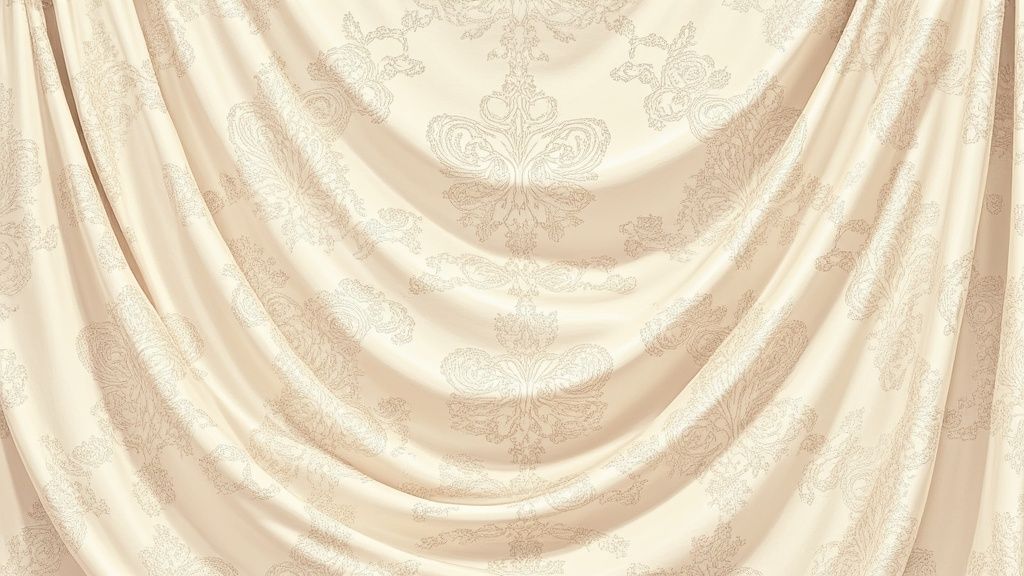
What is Jacquard Fabric? Discover Its Unique Weaving & History
Share
Ever wondered what makes Jacquard fabric so special? It’s a common misconception that Jacquard is a type of material, like cotton or silk. In reality, it’s all about the way the fabric is made—a truly remarkable method of weaving intricate, complex patterns directly into the textile itself.
Instead of being printed or embroidered on top, the design is an integral part of the fabric's structure. This makes it incredibly durable, richly textured, and gives it that luxurious, tactile feel you can't get any other way.
The Art of Woven Design
So, what is Jacquard fabric in simple terms?
Think of it like the difference between a photograph and a mosaic. A printed fabric is like that photograph—the image simply sits on the surface. Jacquard, on the other hand, is a mosaic. The picture is painstakingly built right into the structure, piece by piece, by weaving different coloured threads together to form the final design.
This unique weaving technique creates patterns that are not only beautiful but also built to last. Because the design is literally part of the fabric's DNA, it won’t fade, crack, or peel away over time. It's this beautiful resilience that makes jacquard the perfect choice for high-quality items designed for a long life, like our Me Te Amo bags, elegant home furnishings, and statement clothing.

This ingenious method was first dreamed up by French weaver Joseph-Marie Jacquard way back in 1804. His invention used a clever system of punched cards to automate the loom, allowing for the creation of stunningly complex patterns that were previously impossible to produce on a large scale.
While the technology has evolved, that core principle remains. Over the last two decades, traditional handloom clusters across India have increasingly adopted modern jacquard machines. This has helped them boost productivity while creating fashionable, intricate designs that blend heritage with contemporary style. You can learn more about the evolution of this fabric and its origins if you're curious!
Jacquard Fabric at a Glance
To wrap your head around what makes this fabric stand out, here's a quick summary of its defining features. This little table breaks down what sets Jacquard apart from other textiles you might encounter.
| Characteristic | Description |
|---|---|
| Woven Pattern | The design is integrated directly into the fabric's structure, not printed on the surface. |
| Durability | Since the pattern is part of the weave, it is highly resistant to fading and wear. |
| Texture & Weight | It often has a substantial weight and a distinct, tangible texture that adds a luxurious feel. |
| Reversibility | Many jacquard fabrics are reversible, with the pattern's colours appearing inverted on the back. |
| Versatility | It can be made from various fibres like cotton, silk, and synthetics, for different uses. |
Essentially, when you choose a Jacquard fabric, you're getting a piece where the beauty isn't just skin deep—it's woven right into its very core.
The Story Behind This Groundbreaking Weave
Every fabric has a backstory, and jacquard's tale is a particularly fascinating one, woven deep into history. To really get why it’s so special, we need to travel back to France in the early 19th century. Long before any kind of automation, creating fabric with intricate patterns was an incredibly slow, difficult, and expensive process.
This was the kind of work that only master weavers and their assistants could tackle, which meant these beautiful patterned textiles were a luxury only the wealthiest could ever hope to own. The sheer skill and time involved put a cap on how complex the designs could be and how much fabric could be produced. Artistry was literally being held back by the technology of the time.

A Precursor to Modern Computing
Then, a man named Joseph-Marie Jacquard came along and changed the game. In 1804, he introduced an incredible device that attached to a loom. It used a series of punched cards—an idea that, believe it or not, laid the groundwork for modern computers—to automatically control which threads were lifted during the weaving process.
Think of it like this: each card represented one row of the design, and the holes punched into it told the loom which threads to raise. This simple but brilliant system made it possible to weave complex patterns automatically, speeding up production immensely and making ornate fabrics accessible to more than just the super-rich.
This was a true game-changer. Suddenly, weavers could create patterns with a level of detail and scale that was previously unthinkable. It beautifully bridged the gap between handcrafted artistry and mechanical production, a conversation that's still relevant today. We dive deeper into this topic in our article on handmade vs. machine-made bags.
From European Looms to Indian Artistry
While the Jacquard loom was born in Europe, its impact rippled across the world and eventually found its way to India. Of course, India already had its own ancient and incredibly rich history of textile making, famous for its exquisite silks and cottons. This existing expertise, especially in traditional silk-weaving centres like Varanasi, created the perfect environment for this new technology.
Indian artisans didn't just adopt the Jacquard loom; they fused it with their own traditional motifs and artistic sensibilities. This blend of modern efficiency and timeless artistry is what allows us to create the beautiful, durable, and accessible jacquard fabrics we use for our Me Te Amo bags today.
How the Jacquard Loom Weaves Its Magic
So, what’s the secret behind those breathtakingly detailed patterns you see in jacquard? It all comes down to the loom's incredible ability to control individual threads—a concept that was seriously ahead of its time. The best way to think about it is less like a standard loom and more like an old-school player piano, but for weaving.
In the original system, a design was first mapped onto a series of punched cards. Each card corresponded to one single row of the pattern. As these cards were fed through the loom, the holes dictated which vertical threads (the warp) would lift up. This allowed the horizontal thread (the weft) to pass underneath them. If there was no hole, the thread simply stayed put.
This simple yet brilliant process is repeated row after row, building the design directly into the fabric's structure. It's a world away from a basic plaid, where threads just follow a simple over-under repeat. The jacquard loom can create virtually any design you can imagine.
From Punch Cards to Digital Precision
Today’s jacquard looms have swapped the physical punch cards for digital files, but the fundamental idea is exactly the same. A computer now tells the loom which threads to lift for every single pass, which allows for even more intricate and flawless patterns. It’s how you can get gorgeous florals, sharp geometrics, and swirling abstract shapes all woven together in one seamless piece of fabric.
This image gives you a quick look at how it all comes together.

As you can see, it's a journey from a creative idea to a precise mechanical action that literally builds the pattern into the cloth. This complete control over every thread is what gives jacquard its signature strength and integrated design. It’s a completely different league from fabrics that just have a pattern printed on top.
The key takeaway is this: With jacquard, the design isn't an afterthought applied to the surface. It is the fabric itself, constructed thread by thread for a richer, more durable, and beautifully textured result.
This process demands incredible skill and precision, turning every piece of fabric into a small work of art. It's a level of artistry that shares its soul with other textile crafts, something you can see in our look at beautiful handmade embroidered bags. Once you understand the process, you really start to appreciate the craftsmanship that goes into every single jacquard bag.
Exploring the Different Types of Jacquard Fabrics
Now that you have an idea of how jacquard is made, you'll probably start spotting it everywhere. The word "jacquard" isn't just one type of fabric; it's a whole family of them. While they're all created using that same amazing loom that weaves the pattern right into the material, each one has its own distinct character and feel.
Knowing the main players helps you appreciate the incredible craftsmanship that goes into each piece. Let's break down the most common types you'll come across, from fancy formalwear to the gorgeous patterns on bags and home furnishings.

Brocade: The Bold and Beautiful
First up is brocade, which is easily the most glamorous member of the jacquard family. If jacquard had a fancy cousin who loves the spotlight, it would be brocade.
It’s famous for its rich, raised patterns that almost look like they’ve been embroidered onto the fabric. This look is created by adding extra threads—often in multiple colours, including shiny metallic ones—that "float" on top. The result is a lavish, almost three-dimensional effect that really makes a statement, which is why you see it in formal gowns, plush cushions, and ornate furniture.
Damask: The Subtle and Sophisticated
Next, we have damask, the master of understated elegance. Unlike its showy cousin brocade, damask's patterns are completely flat and integrated into the fabric.
The real magic of damask is in the subtle play of light and shadow. The pattern emerges from weaving shiny satin threads against a dull, matte background. This clever contrast makes the design shimmer and fade as the light changes, giving it a wonderfully graceful quality.
Damask is also often reversible, with the pattern appearing as a negative image on the back. This makes it a go-to choice for things like tablecloths, curtains, and high-end bedding.
Matelassé: The Quilted and Cosy
Finally, let's talk about matelassé (pronounced mat-la-say). This type of jacquard is designed to look and feel quilted, but here’s the trick—there's no padding at all. The puffy, cushioned texture is created purely by the weave itself, using different thread tensions to make the pattern pucker and rise. It's incredibly soft to the touch and has a lovely, substantial weight.
Seeing these variations really highlights how incredibly versatile the jacquard weave is. The same core technique can give us everything from a fabric fit for a palace to the cosy yet durable material we adore for our bags. To see this versatility in action, check out the beautiful patterns on our Me Te Amo Mochi Sling Bags.
Why Jacquard Is a Smart Choice for Your Home and Wardrobe
Let's be honest, when you're investing in something special—whether it's a statement bag or a new sofa—you want it to be more than just a pretty face. You need it to last. This is where jacquard really comes into its own, offering a perfect blend of toughness, style, and serious staying power.
The biggest win here is its incredible durability. Because the pattern isn't just stamped on top, it’s literally woven into the fabric's DNA. Think about it: printed designs can fade, crack, or peel away over time, but a jacquard pattern is there for good. This makes it an absolute champion for things that get a lot of use, like your everyday armchair or that favourite coat you'll be reaching for years from now.
Enduring Style and Structure
Another thing you'll love is the fabric's natural weight and structure. This gives jacquard a gorgeous, elegant drape that just feels expensive and looks incredibly chic. It also has a secret weapon: it’s remarkably wrinkle-resistant. You can toss a jacquard bag in the back of your car or stuff a jacquard blazer into a suitcase, and it’ll come out looking far better than most other fabrics.
This built-in resilience is exactly why jacquard is such a smart investment. You're not just buying an item; you're choosing a piece that will hold its colour, pattern, and shape for the long haul.
The benefits speak for themselves, no matter how you use it:
- For Home Décor: Even a single jacquard cushion or throw can instantly inject a dose of luxury and texture, making the whole room feel more pulled together.
- For Your Wardrobe: A jacquard coat or bag is the kind of thing you'll keep forever. It’s a true heirloom piece that stays stylish and stands up to real life, season after season.
This mix of strength and elegance makes jacquard incredibly versatile. It shares that same spirit with other sturdy, natural materials that are both beautiful and hardworking. You can see how different textiles offer their own unique advantages in our guide to stylish jute bags for ladies.
Ultimately, when you choose jacquard, you're choosing lasting quality. It’s a fabric that works hard behind the scenes while looking effortlessly beautiful—a truly intelligent addition to your life.
How to Care for Your Jacquard Textiles
So, you’ve got a beautiful jacquard piece, maybe one of our bags, and you want to keep it looking fabulous. I get it. The great news is, it’s not as high-maintenance as you might think. The number one thing that dictates how you’ll care for it is the material it’s actually made from.
Always, always check the care label first—that’s your golden rule. But for a general idea, fabrics made from cotton or synthetic blends are usually pretty tough. You can often pop them in the washing machine on a gentle cycle with cool water and a mild soap. On the other hand, if your jacquard is woven from delicate stuff like silk or wool, it's best to leave it to the professionals and opt for dry cleaning to keep its shape and shine.
Simple Steps for Lasting Beauty
For any items you can wash at home, a couple of simple tricks will keep them looking their best. Steer clear of high-heat drying at all costs; it can really mess with the fibres and that gorgeous pattern. The safest bet is to let your jacquard air dry, but keep it out of direct sunlight.
Pro Tip: If you absolutely have to iron your jacquard, flip it over and press it on the reverse side. Always use a low-heat setting. This way, you smooth out wrinkles without flattening the lovely, raised texture of the weave.
Now, what about those little spills and stains on a bag? The key is to act fast.
- First, gently blot the spot with a clean, damp cloth. Don't rub!
- If it’s a bit stubborn, use a tiny drop of mild soap on the cloth.
- Blot, don’t scrub. Aggressive rubbing can pull at the threads and ruin the pattern.
A little bit of care goes a long way in making sure your jacquard pieces stay stunning for years. It’s this same commitment to quality and detail that we pour into our entire collection of beautifully handcrafted tote bags.
Still Curious About Jacquard? Let's Clear Things Up.
To wrap things up, let's tackle a few of the most common questions that pop up when people first discover jacquard fabric. Think of this as a quick chat to clear up any final thoughts.
Is Jacquard a Natural or Synthetic Fabric?
This is a great question, and the answer is surprisingly simple: it can be either! Jacquard isn't about the material itself; it’s all about the weave. This means you can find gorgeous jacquards made from natural fibres like cotton and silk, but also from hard-wearing synthetics like polyester. The fibre choice really just comes down to the kind of look, feel, and function the designer is going for.
What’s the Difference Between Jacquard and Damask?
Ah, a classic question. While both are born on a jacquard loom, the real difference is in the final look. Damask is a very specific style of jacquard, famous for its single-colour, reversible patterns. You know those elegant, subtle designs on a fancy tablecloth? That's damask, created by playing with shiny satin weaves against a matte background.
"Jacquard," on the other hand, is the umbrella term for any fabric with a pattern woven directly into its structure. This includes much more complex, multi-coloured designs like brocade. So, a good way to remember it is: all damask is jacquard, but not all jacquard is damask.
How Can You Tell Real Jacquard from a Print?
Here’s a simple trick: flip it over! A genuine woven jacquard will have a "negative" of the pattern on the back. You'll see the same design, but the colours might be inverted or you'll see long threads called "floats" that make up the pattern on the other side. A printed fabric? It’ll usually just have a plain, solid-coloured back because the design was simply stamped onto the surface.
Ready to bring the timeless elegance of jacquard into your own wardrobe? Dive into the world of Me Te Amo and discover our stunning, artisan-crafted bags—each one has a story to tell. Shop the full collection today!
